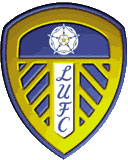 |
 |
 |
History
of the Club - Organising the game
The
Victorians bring order
It was in England in the second half of the Nineteenth Century that football
began Football was promoted by several progressive and reforming headmasters,
such as Dr Thomas Arnold at Rugby and the Reverend Edward Thring at Uppingham,
who, according to Hunter Davies in Boots, Balls and Haircuts, saw
it as 'a way of installing order and discipline and also providing a healthy
activity for adolescent boys, distracting them from possibly more anti-social
or even disgusting personal activities. Many of these reforming headmasters
were clerics, muscular Christians who believed sport was good for the
soul, not just the body. The rules of their traditional school games were
formalised, inter-house competitions encouraged, with victors and champions
recognised and rewarded.' This period in English history also saw a fierce distinction between
the handling codes and the dribbling game. There were major differences
in values and approach between the proponents of each code, and endless
soul searching and debate about which was the worthier. The separation
into discrete and individual codes was messy and prolonged, but eventually
football evolved into three distinct streams - Rugby Union, Rugby League
and Association, the name of which gave rise to the shortened term of
'Socker'. The real birth of football as an organised sport came on Monday, 26 October
1863, when a meeting was convened of representatives from a dozen of the
leading London and suburban football clubs of the day:
The meeting took place at the Freemasons' Tavern in Great Queen Street,
Lincoln's Inn Fields, London, and it was agreed that 'the clubs represented
at this meeting now form themselves into an association to be called The
Football Association.' However, it took another six meetings to formulate
the rules of football. The problem lay in co-ordinating the disparate codes of football played
around the country. There was a strong body of opinion in favour of banning
some of the practices allowed by the Rugby (School) code, already outlawed
by the Sheffield Rules of 1857 and the Cambridge Rules of 1862 and 1863.
But representatives of the Blackheath club, strong advocates of the Rugby
game, were unyielding. They insisted on the inclusion of two clauses in
the rules: first, that 'A player may be entitled to run with the ball
towards his adversaries' goal if he makes a fair catch' and, second, 'If
any player shall run with the ball towards his adversaries' goal, any
player on the opposite side shall be at liberty to charge, hold, trip
or hack him, or wrest the ball from him.' Finally, the dispute came to a head at a meeting held on 1 December,
the fifth such assembly of the new Football Association. A request by
the Blackheath group to adjourn the session was defeated by 13 votes to
4, and as a consequence they withdrew from the Association. The Laws of
the Game, evolved from the Cambridge Rules and now agreed by the FA, were
formally accepted, heralding the birth of Association Football. These first FA Laws were as follows: 1 - The maximum length of the ground shall be 200 yards, the maximum
breadth shall be 100 yards, the length and breadth shall be marked off
with flags; and the goal shall be defined by two upright posts, eight
yards apart, without any tape or bar across them. 2 - A toss for goals shall take place, and the game shall be commenced
by a place kick from the centre of the ground by 3 - After a goal is won, the losing side shall be entitled to kick off,
and the two sides shall change goals after each goal is won. 4 - A goal shall be won when the ball passes between the goal-posts or
over the space between the goal-posts (at whatever height), not being
thrown, knocked on, or carried. 5 - When the ball is in touch, the first player who touches it shall
throw it from the point on the boundary line where it left the ground
in a direction at right angles with the boundary line, and the ball shall
not be in play until it has touched the ground. 6 - When a player has kicked the ball, any one of the same side who is
nearer to the opponent's goal line is out of play and may not touch the
ball himself, nor in any way whatever prevent any other player from doing
so, until he is in play; but no player is out of play when the ball is
kicked off from behind the goal line. 7 - In case the ball goes behind the goal line, if a player on the side
to whom the goal belongs first touches the ball, one of his side shall
be entitled to a free kick from the goal line at the point opposite the
place where the ball shall be touched. If a player of the opposite side
first touches the ball, one of his side shall be entitled to a free kick
at the goal only from a point 15 yards outside the goal line, opposite
the place where the ball is touched, the opposing side standing within
their goal line until he has had his kick. 8 - If a player makes a fair catch, he shall be entitled to a free kick,
providing he claims it by making a mark with his heel at once; and in
order to take such a kick he may go back as far as he pleases, and no
player on the opposite side shall advance beyond his mark until he has
kicked. 9 - No player shall run with the ball. 10 - Neither tripping nor hacking shall be allowed, and no player shall
use his hands to hold or push his adversary. 11 - A player shall not be allowed to throw the ball or pass it to another
with his hands. 12 - No player shall be allowed to take the ball from the ground with
his hands under any pretext whatever while it is in play. 13 - No player shall be allowed to wear projecting nails, iron plates,
or gutta percha on the soles or heels of his boots. Despite the consensus view among the FA's members regarding these rules,
they were not universally accepted. For instance, both Glasgow's Queen's
Park, Scotland's first club, who were formed in 1867, and most of the
Sheffield clubs continued to operate with a number of variations. However,
both communities came into line with the FA in 1870, allowing matches
to be played to common rules between sides from all over the country. It was about the same time that positional play and team formations started
to assume importance. According to the Association of Football Statisticians:
'The new generation of footballers sought a scientific side to their endeavours
on the field. It was no longer sufficient merely to play football - one
had to play with purpose. A step to be taken in this direction was in
the deployment of forces, who should stand where, and who should do what. 'In the general run of football it had always been a case of every man
for himself, each doing 'Under the Association type of football, a favoured method was to employ
a full-back, a half-back, and eight forwards. Using this system, the full-back
was advised to 'brook no delay' in sending the ball into his opponents'
half of the field, the forwards to play in a close pack, a sort of scrummage,
backing up the man on the ball, and the half-back to kick or dribble at
his discretion. 'Queen's Park, in common with most of the Scottish association clubs,
deployed their men in the form of two full-backs, two half-backs, and
six forwards, the forwards themselves frequently operating in pairs, two
on the right wing, two on the left wing, and two in the centre. Notwithstanding
the demonstration of the excellence of this formation, the English clubs
preferred other means of placing ten men and a goalkeeper. The Scottish
style was suitable for the short-passing game, but it found little favour
south of the Tweed, and even less south of the Trent. The Englishmen were
wedded to the principle of individual play, the man on the ball endeavouring
to steer it by close dribbling through the ranks of his adversaries, while
his colleagues were supposed to stick right behind him to back him up,
as it was described, and to carry on the forward dribbling rush should
he be tackled; those few players not so engaged were expected, should
the ball come their way, to return it over the half way line with as little
delay as possible.' It was not until the late 1880's that the classic formation of two full-backs,
three half-backs and five forwards was popularly adopted, with the new
approach having less regard for the previously favoured dribble and headlong
rush through the middle. The emphasis now lay on usage of the wings, where
the defence was most sparse, to allow the cross into the centre and force
a panic in the penalty area. This change was prompted by alterations to the offside law in 1866. Previously,
any player who was in front of the ball when it was played was deemed
offside, effectively outlawing the forward pass. This rule was changed,
allowing advanced players to legally receive a pass providing there were
at least three opponents between themselves and the goal line. This reduced
the importance of dribbling and led to a preoccupation with a passing
game, both long and short, which was quickly mastered by Scottish clubs
and players, giving them a distinct advantage over their English counterparts. The Association of Football Statisticians: 'The superiority of the Scottish
'combination' game over the English style of individual dribbling and
backing-up was amply demonstrated when Queen's Park beat Notts County
by 6 goals to none at Hampden Park. When Englishmen had the ball they
were dangerous, though the Scottish pair of backs were well able to deal
with the menace. However, Notts had no answer to the speed and precision
of the short-passing game whenever Queen's Park had possession in that
match; they were running round in circles, never knowing where the ball
would pop up next.' The FA grew rapidly in importance following its formation and much of
its progress was due to the direction provided by a celebrated triumvirate
of leaders: Major (later Sir Francis) Marindin, RE, who became president
in 1874; Charles W Alcock, captain of the Wanderers FC, a leading side
from London who were composed of the best players to have graduated from
the public schools and universities, who became FA secretary in 1870;
and the Hon A F (later Lord) Kinnaird, captain of the Old Etonians FC,
who became FA treasurer in 1878. Geoffrey Green: 'Alcock, supported by the military discipline of Marindin
and the social graces of The major milestone in this jounrey came when the Football Association
finally recognised that there was a need for some form of organised competition.
Alcock the moving spirit in the inception of the Football Association
Challenge Cup competition. At a meeting held in the offices of The Sportsman in London on 20th July
1871, Alcock proposed 'that it is desirable that a Challenge Cup should
be established in connection with the Association, for which all clubs
belonging to the Association should be invited to compete'. The move received
support and was finally approved three months later, on 16 October. There were 15 entrants for that first competition, but none of them were
from Northern clubs, their fixture cards for the season having already
been agreed. There were only two non-Southern clubs (Scotland's Queen's
Park and Lincolnshire's Donington School). The other 13 clubs (Barnes,
Civil Service, Clapham Rovers, Crystal Palace, Hampstead Heathens, Harrow
Chequers, Hitchin, Maidenhead, Marlow, Reigate Priory, Royal Engineers,
Upton Park and Wanderers) were all from London and the Home Counties. Both Queen's Park and Donington were given byes in the first round, and
then Queen's Park had a walkover in the second when Donington scratched.
With five clubs left in the third round, Queen's Park received another
bye, so were in the semi finals without having played a match. They were
drawn against the Wanderers, and travelled to London from Glasgow with
the help of public subscription. After a hard-fought goalless draw, Queen's
Park, whose accurate passing style was a complete revelation in the South,
could not afford to stay in London for a replay and had to scratch. So
Wanderers were in the final. The Royal Engineers were favourites to win the final at odds of 7-4 on,
but the Wanderers secured a 1-0 victory to become the first holders of
the Cup in front of a crowd of 2,000 on 16 March 1872 at Kennington Oval.
It was fitting that Alcock should be the first captain to raise the trophy,
a silver cup scarcely 18 inches high. The following November saw the first ever international match, between
England and Scotland, held at the West of Scotland Cricket Ground, Partick.
The game finished in a 0-0 draw, which was something of a shock with the
number of attackers on the field. The formation of the Scottish FA was
still a year away, so the 'Scotland' side was organised by Queen's Park,
who provided six of the players. At this time, football was an avowedly amateur sport, played purely for
fun and exercise, with no commercial reward. The FA was founded by amateurs,
and all of the original entrants for the Cup were amateur. The 'amateur
era' was dominated by the In these early days, there was no thought of anyone being paid for their
participation. The very idea was anathema to the gentlemen players who
dominated the game and against all their ideals of sport and sportsmanship.
Things began to change with the coming of competition and the Cup, which
had its opponents who argued that the rivalry generated would lead to
the destruction of the true spirit of the game. In some respects they
were right. A direct outcome of the enthusiasm to win the 'little tin
idol' was the subversive growth of professionalism and the resulting transition
of power from the South to the North of England. Professionalism was finally
recognised in England in 1885. The Association of Football Statisticians: 'There was a feeling in Lancashire
that eventually some form of professionalism would have to be made legal.
In the end he Football Association would have to agree that some players
had to be paid. If it would not sanction the actual payment of wages,
then there would have to be a system whereby men were compensated for
time lost from work. 'The business was brought up at a meeting of the national body on 25
June, 1884. The Blackburn Rovers representative said that if players could
not be compensated for lost wages it would be the end of football for
working people in Lancashire. Major Marindin, from the Chair, said the
proposal was to alter the rules so that as well as actual out-of-pocket
expenses, loss of not more than one day's pay could be claimed. He said
the Committee did not like this "wages clause", but he realised
that its deletion would bear hardly on working men. Mr. Forrest (Lancashire),
said he would prefer that two days' loss of pay could be claimed, whereupon
Mr. Clegg argued, "if one, why not three, or even six?." There
ought not to be a wages clause at all. Mr. Pierce Dix, of Sheffield, bitterly
opposed the liberal attitude to loss of wages. They had gone over it before,
he said, and decided against it; now they seemed to be trying to upset
that verdict. Mr. Crump (Birmingham) said he did not consider football
should be limited to one class. He failed to see how a working man, receiving
a single day's pay for lost wages, could be termed a professional. 'The supporters of professional football argued lucidly and powerfully
and left the door open invitingly for negotiation. Their opponents, honest
men of principle though they were, could only fall back on honesty and
principle and the pessimistic cries that football was being ruined. But
for the most part, the true-blue amateurs of the South (and the Provinces),
listened with growing sympathy to the words of the Lancashire men. However,
they voted against the proposal.' Eventually the tide of professionalism swept over everything, leading
to an increase in the number of players, and the development of more competition. Philip Gibbons: 'Towards the end of the 1887/88 season, in early 1888,
Aston Villa's William McGregor, a committee member of Aston Villa and
a member of the Birmingham FA, sent a circular to five of the leading
professional clubs in England expressing his concern at what he saw as
a crisis in the Association game. 'McGregor, who had been a leading light in the Midlands when arguing
for the legalisation of professionalism, felt that football was in a poor
state, suggesting that a League system should be developed to keep the
competition going rather than the friendly games of little importance.
Fixtures were often cancelled on a Friday evening or Saturday morning
for no particular season, thus depriving thousands of spectators of their
Saturday afternoon sport, while the lack of income brought about by these
cancelled games forced clubs into bankruptcy, unable to pay players their
wages.' The circular, sent on 2 March 1888, read as follows: 'Every year it is
becoming more and more difficult for football clubs of any standing to
meet their friendly engagements and even arrange friendly matches. The
consequence is that at the last moment, through Cup-tie interference,
clubs are compelled to take on teams who will not attract the public. 'I beg to tender the following suggestion as a means of getting over
the difficulty in that ten or twelve of the most prominent clubs in England
combine to arrange home-and-away fixtures each season, the said fixtures
to be arranged at a friendly conference about the same time as the International
Conference. This combination might be known as the Association Football
Union, and could be managed by representative from each club. Of course,
this is in no way to interfere with the National Association; even the
suggested matches might be played under Cup-tie rules. However, this is
a detail. 'My object in writing to you at present is merely to draw your attention
to the subject, and to suggest a friendly conference to discuss the matter
more fully. I would take it as a favour if you would kindly think the
matter over, and make whatever suggestions you deem necessary. I am only
writing to the following - Blackburn Rovers, Bolton Wanderers, Preston
North End, West Bromwich Albion, and Aston Villa, and would like to hear
what other clubs you would suggest. 'PS - How would Friday, 23rd March, 1888, suit for the friendly conference
at Anderton's Hotel, London?' From such humble beginnings, the Football League competition was born. Philip Gibbons: 'As Mr McGregor took his place as president of the League,
it was decided to play the opening League games on 8 September 1888. However,
Mr McGregor was aware of the importance of not falling out with the Football
Association in London. He felt that, together, they would see the game
grow into a healthier state than it had been for a while. He believed
the League competition to be one of skill and consistency, while the FA
Cup would be won by the team playing the most spirited football over a
few games.' McGregor served as president of the League until he retired in 1894.
He was succeeded by Bolton Wanderers secretary-manager JJ (John) Bentley,
who held the role until 1910. Bentley's replacement was Liverpool's 'Honest'
John McKenna, who was elected to the League Management Committee in 1902,
became a vice president in 1908 and remained president until he died in
1936. In total contrast to the Cup when it started, the twelve founding members
of the Football League (Accrington, Aston Villa, Blackburn Rovers, Bolton
Wanderers, Burnley, Derby County, Everton, Notts County, Preston North
End, Stoke, West Bromwich Albion and Wolverhampton Wanderers) were equally
divided between Lancashire and the Midlands; most of them were professional
or at least semi-professional outfits. In 1892, a Second Division was
formed, and again it was made up almost entirely from clubs in the Northern
parts of the country. Only Grimsby and Lincoln City were not from the
North or the Midlands. Blackburn Rovers were the first Northern Cup finalists in 1882, but that
heralded the start of the Lancashire takeover. The plumbers and weavers
of Blackburn Olympic beat the gentlemen of the Old Etonians to take the
Cup up North in 1883, to be followed by their neighbours, Rovers, who
won in 1884, 1885 and 1886. When Preston won the first League and Cup
double Preston North End retained their League title in 1890, but their dominance
was wrested away by Aston Villa, the most successful English side of the
1890's and early 1900's; Villa were champions in 1894, 1896, 1897 (the
year they also won the Double), 1899 and 1900. They won the Cup in 1887,
1895, 1897 and 1905. Their Black Country neighbours, WBA and Wolves secured
the Cup in 1888, 1892 and 1893 and the beaten finalists came from these
same three clubs in 1886, 1889, 1895 and 1896. The only other side which really got a regular look in were Sunderland,
the 'Team of All the Talents'. Packed with Scottish footballers, they
were champions in 1892,1893, 1895 and 1902. Their North East neighbours
Newcastle United were champions in 1905 and lost the FA Cup Final to Villa
that same year. During this period, the new heroes of the game were substantially different
from their forebears, as Hunter Davies records: 'The first football heroes were the amateurs, like Kinnaird and Alcock
and G O Smith of Oxford and the Corinthians, their names becoming known
to all football fans of the time. Vivian Woodward of Spurs, one of the
last amateur stars to play in a professional team, became famous when
he scored six goals for England against Holland in 1909. But it was the
professional players who quickly became household names, in football households,
such as John Goodall, inside forward for the Preston North End "Invincibles"
team of 1889. Forwards, like Billy Bassett, tended to become the stars,
as they do today, attracting all the headlines, acclaimed as "Wizards
of Dribble". Steve Bloomer of Derby was famous as a prolific goalscorer,
scoring 353 League goals between 1892 and 1914. As early as 1892, one
commentator, C Edwards, was writing that star players were becoming "better
known than the local member of Parliament".' Spartacus Educational: 'In the 1896/97 season Sheffield United were runners
up behind the double-winning Aston Villa ... In the home game against
the champions, Foulke caused a stir by bouncing the ball as far as the
halfway line. This was within the rules at the time, but as players were
able to barge into other players when they had the ball, goalkeepers saw
that tactic as very risky. However, Foulke was fairly confident that he
would be able to regain possession of the ball. C B Fry, the famous cricketer,
who also played football for Southampton, remarked: 'Foulke is no small
part of a mountain. You cannot bundle him.' 'Foulke won his first international cap against Wales on 29 March 1897.
Although England won 4-0, surprisingly, it was the only time he played
for his country ... As the Sheffield Daily Telegraph pointed out:
"It is a pity that Foulke cannot curb the habit of pulling down the
crossbar, which on Saturday ended in his breaking it in two. On form,
he is well in the running for international honours, but the Selection
Committee are sure to prefer a man who plays the game to one who unnecessarily
violates the spirit of the rules." 'In 1895 Foulke only weighed 12st 10lb but over the next few years he
put on a lot of weight and was nicknamed "Fatty" or "Colossus"
by the fans. He once said: '="I don't mind what they call me as long
as they don't call me late for my lunch." ... Foulke was 6ft 2ins
tall. At the time the average height for an adult male was only 5 ft 5
ins and therefore he towered over most of the players. This can be seen
in the team photographs taken at the time. 'In a game against Liverpool in November, 1898, George Allan tried to
intimidate Foulke. The Liverpool Post reported that 'Allan charged
Foulke in the goalmouth, and the big man, losing his temper, seized him
by the leg and turned him upside down.' As the Athletic News pointed
out, when this happened: "He doesn't claim a foul, but simply places
that paw of his on the shoulder of the charging gentleman in a most fatherly
manner, and pushed him aside with an expression of get on one side, little
boy." 'On another occasion he fell on Laurie Bell of Sheffield Wednesday. As
he later recalled: "It was really all an accident. Just as I was
reaching for a high ball Bell came at me, and the result of the collision
was that we both tumbled down, but it was his bad luck to be 'Foulke was also a talented cricketer and played for Blackwell Colliery
in the Derbyshire League. One journalist joked that every time Foulke
went into bat "there is an appeal against the light." 'Foulke's main sport was football and he was also a member of the Sheffield
United team that played Southampton in the 1902 FA Cup Final. Sheffield
took an early lead but Southampton scored a controversial equalizer and
the game was drawn 1-1 ... Foulke was furious that the equalizing goal
had been given after the game he went searching for the referee. The linesman,
J T Howcroft, described how Frederick Wall, secretary of the Football
Association, tried to placate the goalkeeper: "Foulke was exasperated
by the goal and claimed it was in his birthday suit outside the dressing
room, and I saw F J Wall, secretary of the FA, pleading with him to rejoin
his colleagues. But Bill was out for blood, and I shouted to Mr. Kirkham
to lock his cubicle door. He didn't need telling twice. But what a sight!
The thing I'll never forget is Foulke, so tremendous in size, striding
along the corridor, without a stitch of clothing." 'After playing in over 350 games for Sheffield United Foulke decided
to leave the club when he refused to take a pay cut. In May 1905 Foulke
was sold to Chelsea for a transfer fee of £50 ... Chelsea had just joined
the Football League and in his first season he helped them to finish in
3rd place in the Second Division ... However, he continued to put on weight.
According to one report, Foulke was known to arrive early for breakfast,
set for the entire Chelsea team, and eat the lot. 'Foulke only played 35 games for Chelsea before moving to Bradford City
... The Bradford Daily Argus reported that 'there is no doubt that the
mighty goalkeeper is doing a great deal in the direction of inspiring
confidence in the team.' This did not stop the newspaper making fun of
their large goalkeeper. On 29th September, 1906, it reported that a cab
horse had a narrow escape when it nearly collided with Foulke when he
was crossing the Strand. Foulke was quoted as saying: "I would have
jumped on the beggar's back before I would have let him come into me." 'William Fatty Foulke died on 1st May 1916. The death certificate gives
"cirrhosis" as a major cause of death. There is no truth in
the claim that Foulke ended his life in poverty working at a sideshow
on Blackpool beach.' Fatty Foulke was a legend in his time, but probably the best remembered
from that pre-First World War period, in the sense that he still appears
in all the record books, is Alf Common. What a sensation he created in
February 1905 when he was transferred from Sunderland to Middlesbrough
for the then astronomical sum of £1,000, the first ever four-figure transfer
fee. The FA and the League, having imposed a maximum wage, had contemplated
a maximum transfer fee, and in 1899 the FA suggested the limit should
be £10, but they felt unable to impose it, so over the next few years
it slowly crept up to around £400 for the best players. A sudden jump
to £1,000 amazed everyone. An investigation was set up to find out if
anything unlawful had been done. The transfer was all above board, but
when they went through the Boro books, it was revealed they'd paid illegal
Cup bonuses to players in the previous season. Football purists were aghast, saying it was the end of football as they
had known it. Money was ruining the game, players had become mercenaries
with no loyalties, a new form of white slave trade had now been introduced,
where will it end - will we soon have £2,000 transfers or even, perish
the thought, will there one of these days be a £10,000 transfer fee? Part of the surprise was the fact that it was Middlesbrough, a relatively
new club, only six years old. But Boro that season were desperate, struggling
near the bottom of the First Division and badly in need of a goalscorer.
Some things never change. They had tried for one, who turned them down,
and so decided to lash out on Sunderland's bustling, 5ft-8ins-high, 13-stone
Alf Common. Sunderland had bought him from Sheffield United just a year previously
for £350, so naturally Sheffield United were pretty livid that Sunderland
had made such a huge profit in a short time. Charles Clegg, chairman of
the FA, who was also a Sheffield As so often happens in football, with almost predictable irony, Common's
first game for Boro, on February 25, 1905, was away to Sheffield United.
They won 1-0, with Common scoring from a penalty. It was Boro's first
away win for nearly two years and they stayed up, with Common taking over
as captain. So, this first ever shock-horror mega transfer deal was considered
money well spent. Common was a jovial, ruddy-faced, rather tubby player, famous for his
attempts to lose weight.ounds like another well-known North-Easterner,
P Gascoigne. At the age of 30, Common was transferred to Woolwich Arsenal
who devised all sorts of physical exercises and strenuous walks to get
him slim, without much success. When he retired he became a publican,
running the Alma Hotel at Cockerton for 11 years. 'A footballer behind
the bar is as great an attraction as a long-legged giant or a fat woman,'
reported the Athletic Journal as early as 1890. The tradition of players becoming publicans lived on for almost the next
100 years, at least for those who had managed to save a few pounds. Even
as late as 1974, it was what Sir Alex Ferguson first did when his career
with Rangers and Ayr United was coming to an end. At the time, he wasn't
quite sure what to do with the rest of his life. Alf Common was known as a practical joker, but alas none of his wheezes
have survived. Footballers have always been known for their amusing as
well as riotous behaviour. A writer in the Book of Football in 1905 described one of the
tricks which the Newcastle United players got up to while travelling by
train. They had a special saloon provided by the North Eastern Railway
Company, divided into two compartments by a sliding door, where the players
passed the time playing whist. If a bossy ticket collector interrupted
their games by laboriously checking the tickets and counting all the players,
they deliberately set out to confuse him. When the ticket inspector announced
that there were 22 players, yet only 16 tickets, he naturally suspected
some fiddle was going on, and he proceeded to call for the station master.
Only later did he discover that some players had been sliding between
the two doors and had been counted twice. What japes!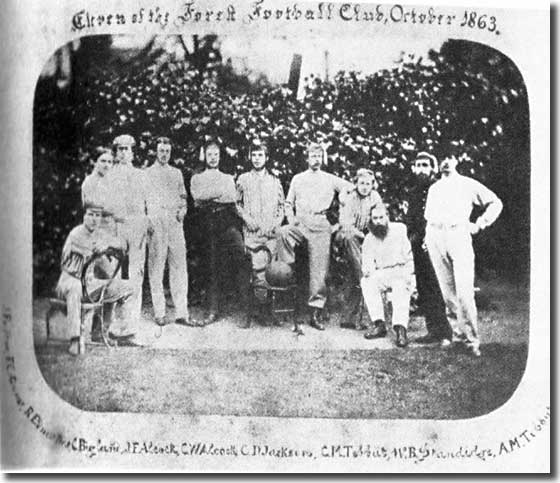 to assume something resembling today's shape, when it became refined and
organised, helped by the advent of a common set of rules and standards.
The Victorian era brought with it many advances, pioneering thinkers and
an urge to bring order in all things.
to assume something resembling today's shape, when it became refined and
organised, helped by the advent of a common set of rules and standards.
The Victorian era brought with it many advances, pioneering thinkers and
an urge to bring order in all things.
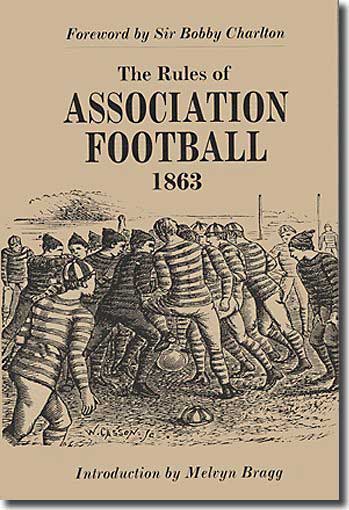 the
side losing the toss for goals; the other side shall not approach within
10 yards of the ball until it is kicked off.
the
side losing the toss for goals; the other side shall not approach within
10 yards of the ball until it is kicked off.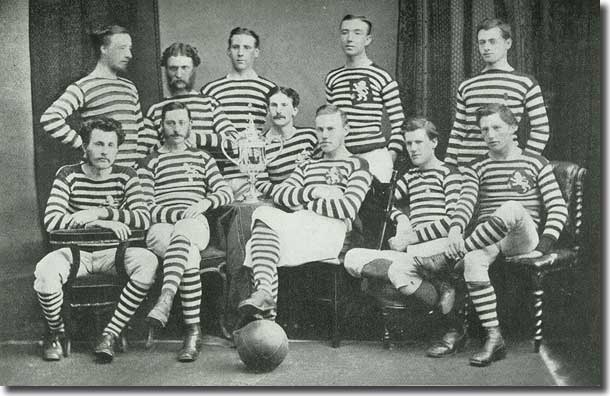 as
he thought best. The new thinking perceived that the best way to the opponents'
line, and the best way of keeping an adversary away from its own end,
could be greatly assisted by the intelligent marshalling of human resources.
as
he thought best. The new thinking perceived that the best way to the opponents'
line, and the best way of keeping an adversary away from its own end,
could be greatly assisted by the intelligent marshalling of human resources.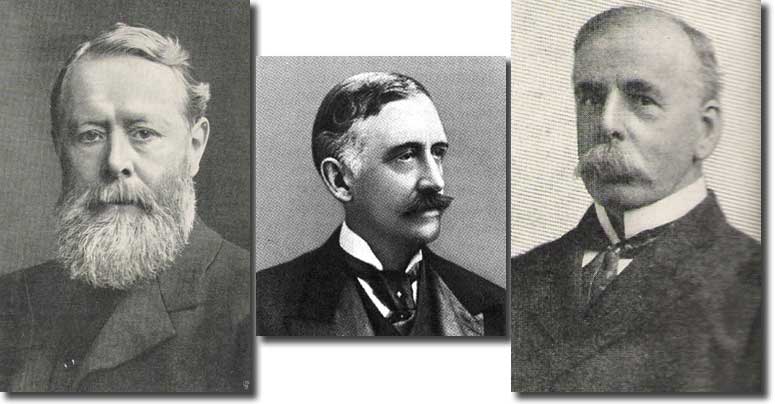 Kinnaird, was the real driving force and genius in his position as secretary,
a rank that in due course was to grow to one of vast importance in the
years of expansion ahead. Alcock was a lover of true sport and sportsmanship.
For a quarter of a century he held the reins of administration while the
character and significance of football underwent a crucial change. The
part he played in all this evolution was beyond measure. That must be
repeated, for it was his idea of the Cup and international football that
finally set the game on its pedestal. He was the one who set a light to
what was one day to become a worldwide fire.'
Kinnaird, was the real driving force and genius in his position as secretary,
a rank that in due course was to grow to one of vast importance in the
years of expansion ahead. Alcock was a lover of true sport and sportsmanship.
For a quarter of a century he held the reins of administration while the
character and significance of football underwent a crucial change. The
part he played in all this evolution was beyond measure. That must be
repeated, for it was his idea of the Cup and international football that
finally set the game on its pedestal. He was the one who set a light to
what was one day to become a worldwide fire.'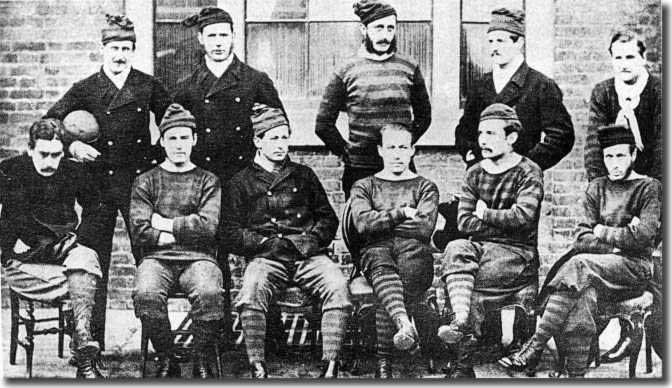 Wanderers
and the Royal Engineers, and other similarly Corinthian outfits like Oxford
University and the Old Etonians.
Wanderers
and the Royal Engineers, and other similarly Corinthian outfits like Oxford
University and the Old Etonians.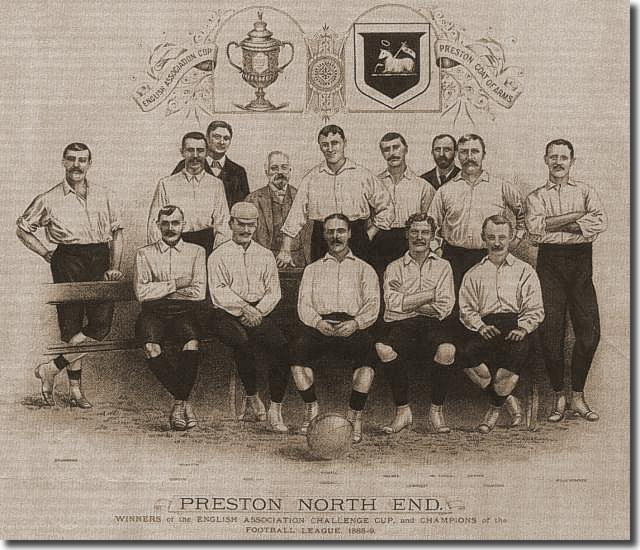
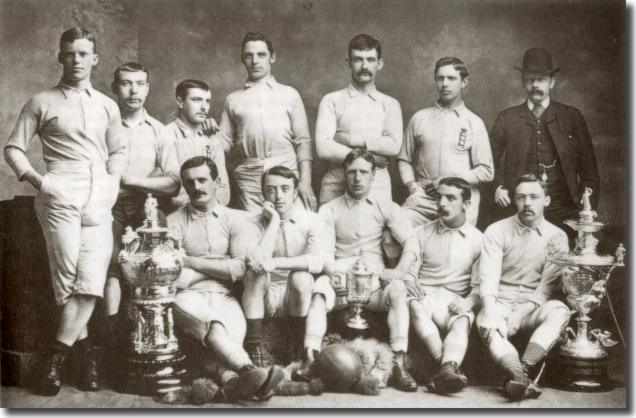
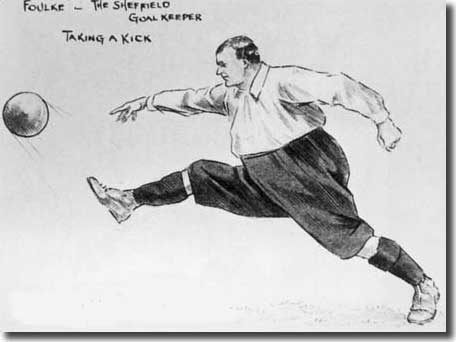 underneath,
and I could not prevent myself from falling with both knees in his back.
When I saw his face I got about the worst shock I ever have had on the
football field. He looked as if he was dead."
underneath,
and I could not prevent myself from falling with both knees in his back.
When I saw his face I got about the worst shock I ever have had on the
football field. He looked as if he was dead."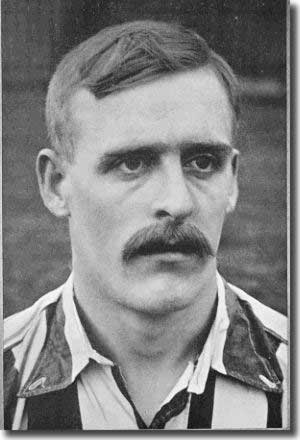 United man, was particularly upset.
United man, was particularly upset.